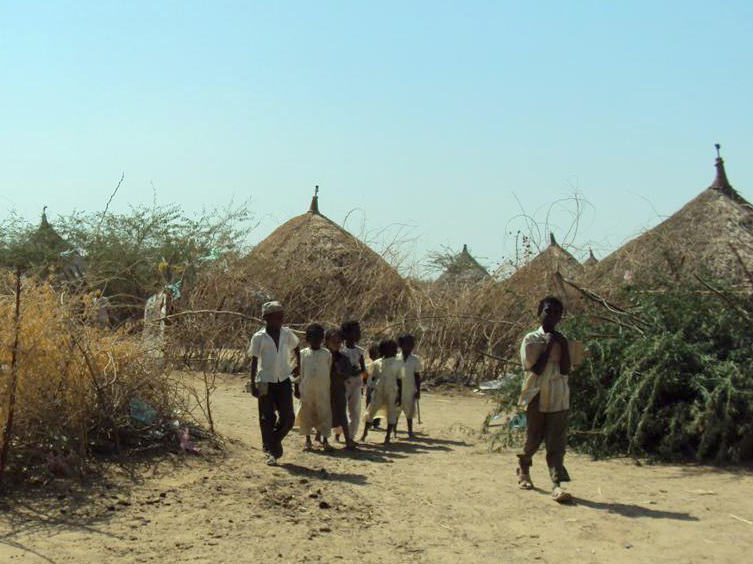"Refugees have been here for the past 30-40 years, which is two to three generations, and that is quite unique,” said Peter de Clercq, the UNHCR representative in Sudan.
“It is as far as we know the longest-standing refugee situation in Africa that is still protracted. That is mostly because of the political situation inside Eritrea," he said.
As they planned for their big escape to Europe or Israel, asylum-seekers dreamed of a better life in Sudan. But instead, thousands woke up to the realities of the grim camp conditions, lacking food security or proper healthcare, and sharing scarce resources with Sudanese nationals. On arrival at the reception centre at Shagarab camp in Kassala state, near the Eritrean border, they are not immediately provided with proper shelter. Only when their refugee status is confirmed, which can take four to six weeks, are they able to move into tents or huts, which they often have to build themselves.
"Living here is difficult. Hearing about it from afar, the camp sounded comfortable, but if you come here it seems like [an Eritrean] national service camp, because you can't have any money," said a 22-year-old Eritrean refugee.
Shagarab, with the worst conditions among the three biggest camps in eastern Sudan, houses more than 21,000 mostly Eritrean refugees, in addition to some Ethiopians and Somalis. The 1,800 monthly arrivals also include young men who flee forced conscription in the Eritrean army.
"I worked in the army for more than 10 years. I left because my family is very poor. Not enough money to live in Eritrea. It is very hard," said another refugee, 34. "We four brothers were in the army, so nobody could feed our family," he added.
The UN World Food Programme supplies the camps with food aid but refugees say it is not enough. Education opportunities for children are also inadequate. Out of 15,000 children in the 12 camps in the east, 6,000 do not get the chance for a primary education because schools lack the capacity to absorb them, UNHCR Africa Director George Okoth-Obbo said later in Khartoum.
|
Photo: Maram Mazen/IRIN  |
| Children at the Wad Sharifey refugee camp, home to 15,020 mostly Eritrean refugees |
In 2002, the refugee status enjoyed by those who had fled the independence war, or subsequent conflict between Ethiopia and Eritrea, was revoked, on the grounds that the circumstances that led to their exodus no longer pertained.
Although thousands of refugees returned to Eritrea, some refused to do so.
A 24-year-old mother of three, born and raised in the Wad Sharifey camp close to the Eritrean border, told IRIN: "I do not want to go back to Eritrea. The reasons for us leaving have not ended."
Most of the refugees stay inside the camps. However, many risk their lives trying to reach Europe or Israel. "We can indeed confirm reports that many people in fact do not make it – people do die in the desert, there is no doubt about that, and there are many dead bodies that wash up on the shore," De Clercq said in Khartoum.
Some of the refugees move to other cities in Sudan looking for employment. The government says there are about 40,000 refugees living in urban centres, sharing services and job opportunities with Sudanese nationals. Although UNHCR says the government has not rejected any Eritrean asylum-seekers, it does try to reduce the pull of the refugee camps to potential ones.
Refugees are allowed to work in Sudan, but government policy is to keep them inside the camps, said Abdallah Soliman Mohamed, deputy commissioner of refugees. With no access to better education for refugee children, and after international donors have supported the camps for more than 40 years, UNHCR says it is looking into other ways for the refugees to become self-reliant.
"The first durable solution for refugees is to go back home. We will always investigate that opportunity. But it doesn’t seem as if in the near future there are any major opportunities for return [to Eritrea]," De Clercq said. "Therefore, the next best solution is the local integration of the refugees in eastern Sudan, and that very much depends on the support we get from the government."
|
Photo: Maram Mazen/IRIN  |
| A woman sits in her home in the Wad Sharifey refugee camp: Eritrea’s policy of indefinite military conscription, coupled with drought and poor economic opportunities, prompt some 1,800 people to cross into Sudan every month, according to the UNHCR |
De Clercq said the UN agency was studying with the Sudanese government possible projects that would lead to the refugees’ self-reliance. Among the projects being discussed is leasing irrigated land to refugees so they can provide for their own food needs and sell the excess produce.
After formulating a comprehensive programme with the Sudanese government, UNHCR says it will present the suggested activities to international donors in 2010, which would require additional funds. UNHCR spent US$16 million this year on the camps.
With no clear end in sight, UNHCR says the refugee problem could be exacerbated as agencies expect a bigger influx of Eritrean and Ethiopian refugees to cross into Sudan in the next few months because of a drought and food shortages.
"There are very clear indications both in Ethiopia and Eritrea, as well as in eastern Sudan that this will be a very bad season. It’s the coming season in the next few months that is going to be really crucial to see whether this will materialize," De Clerq said.
If drought does hit those regions, the numbers of Ethiopians and Eritreans coming into Sudan in the next few months could be as high as "tens of thousands of people", he said.
mm/mw
This article was produced by IRIN News while it was part of the United Nations Office for the Coordination of Humanitarian Affairs. Please send queries on copyright or liability to the UN. For more information: https://shop.un.org/rights-permissions



